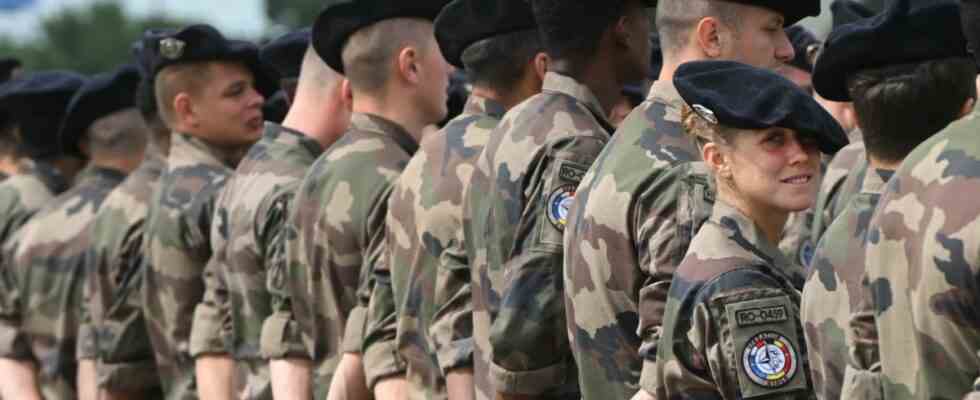NATO and the G-7 countries showed decisive signs of strength on Monday in the face of the ongoing Russian attacks on Ukraine. NATO Secretary General Jens Stoltenberg announced in Brussels that the alliance’s rapid reaction force is to be massively expanded. In the run-up to the NATO summit in Madrid, Stoltenberg announced that it would be increased to well over 300,000 soldiers. Their number would thus increase more than sevenfold. At their summit in Elmau, the G-7 states also announced that they would “continue to look for new ways to isolate Russia from participating in the world market,” according to their statement. Ukrainian President Volodymyr Zelensky addressed the heads of state and government of the USA, Canada, Great Britain, Italy, France, Japan and Germany via video link.
NATO Secretary General Stoltenberg said in Brussels with a view to the upcoming summit meeting in Madrid that the armed forces assigned to the “NATO Response Force” (NRF) would be increased from the current 40,000 “to more than 300,000” soldiers. He also expressed the expectation that the 30 NATO members would describe Russia as the “most important direct threat” to the transatlantic alliance in their updated “strategic concept”.
The enormous number for the rapid reaction force hides a fundamental change in NATO’s military planning. The conversion announced by Stoltenberg is part of the new armed forces model for the entire alliance area, for which significantly more soldiers are planned to be on high alert. In addition, armed forces are to be assigned to specific areas in the future. German soldiers should be scheduled to support Lithuania in the event of a Russian attack.
Since 2017, the Bundeswehr has been leading a multinational battalion-size battle group in Lithuania, i.e. with around a thousand soldiers. Similar forces were also stationed in Poland, Estonia and Latvia in response to Russia’s annexation of Crimea in 2014. After Russia’s attack on Ukraine this February, these “EFP battlegroups” were expanded and combat units were set up in Romania, Slovakia, Hungary and Bulgaria. According to Stoltenberg, these battlegroups could in future comprise “up to one brigade”, i.e. between 3,000 and 5,000 soldiers. Chancellor Olaf Scholz (SPD) announced at the beginning of June that the federal government was ready to set up “a robust combat brigade” in Lithuania. However, the soldiers are to remain stationed in Germany.
NATO’s basic plans provide for the armed forces of the rapid reaction force NRF to be under national command in peacetime. In an emergency, the forces should be able to be requested from the NATO commander-in-chief. The NRF troops would also be given fixed times for operational readiness. It is being discussed that some units should be ready for relocation after a maximum of ten days, others in 30 or 50 days. This is likely to require high costs for procurement of equipment, ammunition and equipment, as well as constant exercises.
At the G-7 meeting at Schloss Elmau in Bavaria on Monday, the central theme was the reaction to the Russian invasion of Ukraine. According to reports, the heads of state and government consulted after a good two hours with the Ukrainian president, who was connected via video. In the conversation, Volodymyr Zelensky asked for further help for his country and warned of a difficult situation if the war is not ended before winter. He therefore asked for air defense systems and more ammunition. According to information from negotiating circles in the round, US President Joe Biden said that Russia must not win the war. Chancellor Scholz sees the West’s relations with Russia as permanently broken. In this relationship, there can be no going back to the time before the war, says Scholz in Elmau. By attacking Ukraine, the Russian government broke all agreements on international cooperation.
The G-7 countries pledged a further 28 billion euros in support for Ukraine’s state budget. This is intended to put the government in Kyiv in a position to ensure the basic needs of the people in the country. In view of the sanctions against the government of President Vladimir Putin, the G-7 countries set themselves the goal of massively reducing Russia’s income from trading in raw materials. This should also include trading in gold. According to reports, negotiations were also being held on ways to put a price cap on Russian oil.
The heads of state and government expressly placed the decision on a peace agreement with Russia in the hands of the government in Kyiv alone. According to the G-7 statement, Ukraine will decide on a future peace settlement, which should be “free of external pressure or influence”. The G7 also pledged further military aid to Ukraine for as long as the country needs it.
The G-7 states promised Ukraine far-reaching security guarantees, also for the post-war period. Together with interested countries and institutions, they want to reach agreements with Kyiv on sustainable security obligations “to help Ukraine to defend itself, to secure its free and democratic future and to ward off future Russian aggression,” says the G-7 Explanation.

